- | Academic & Student Programs Academic & Student Programs
- | Corporate Welfare Corporate Welfare
- | Policy Briefs Policy Briefs
- |
The State of Occupational Licensure in Illinois
Occupational licensing is ostensibly intended to protect the public from unsafe and low-quality service. But a broad and growing consensus among economists suggests that these rules mostly serve to protect incumbent providers from competition, raising consumer prices and limiting opportunities for new entrants in the field without improving quality. In this policy brief, we focus on occupational licensing in the state of Illinois and put that state’s practices into the broader context of existing economic research.
A Snapshot of Illinois’s Occupational Licensure Regime
The share of the workforce required to have an occupational license has increased significantly in recent decades. While there is a great deal of variation across states in the number of industries that require occupational licenses as well as in the requirements to obtain an occupational license, this increase is evident nearly everywhere.
A 2015 study by economics professor Morris M. Kleiner, the leading expert on occupational licensure, determined that 24.7 percent of the workforce in Illinois was licensed and 5 percent of the workforce was certified. Based on these estimates, the Illinois Policy Institute, using data from the Bureau of Labor Statistics, deduced that roughly 1.6 million Illinoisans are currently required to have a license to legally practice their occupation.
By some measures, Illinois’s occupational license requirements appear a little less burdensome than those in the average state; by other measures, they appear slightly more burdensome. In a 2012 Institute for Justice (IJ) study examining the occupational licensure laws for 102 low- to moderate-income occupations, Illinois licensed 40 out of the 102 industries studied, including athletic trainer, barber, bus driver, and manicurist. Based on the number of licensed occupations and the requirements to obtain a license, IJ ranked Illinois the “30th most extensively and onerously licensed state.” The IJ study concludes that an individual who attempts to gain employment in one of the 40 occupations studied can, on average, expect to pay “$249 in fees, lose 203 days to education and experience mandates and take one exam.”
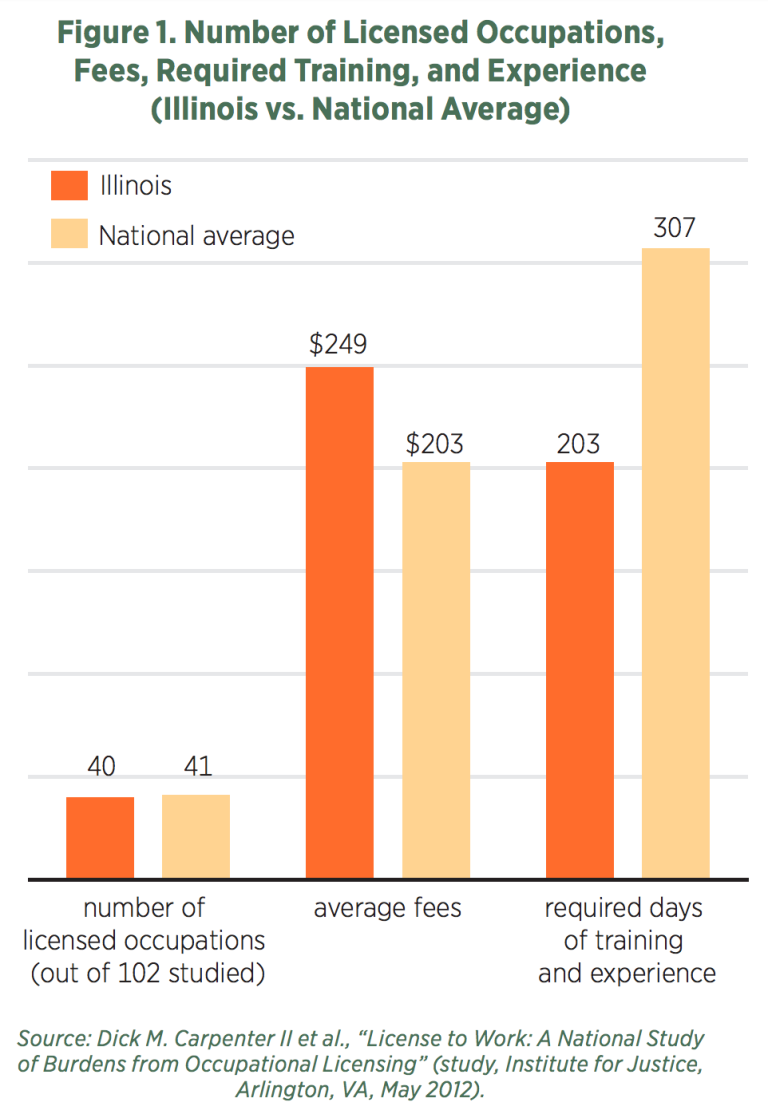
While proponents of occupational licensure claim that these rules protect public safety, the pattern of requirements across occupations belies this notion. Occupations that are less likely to involve risk to the public are often more highly controlled than riskier occupations. Cosmetologists, for example, are required to have more than 13 times the amount of education and experience required of emergency medical technicians (EMTs).
As shown in table 1, this type of regulatory mismatch is not limited to cosmetologists. Illinois requires security alarm installers, barbers, makeup artists, pest control applicators, auctioneers, and massage therapists to undergo significantly more training than EMTs.
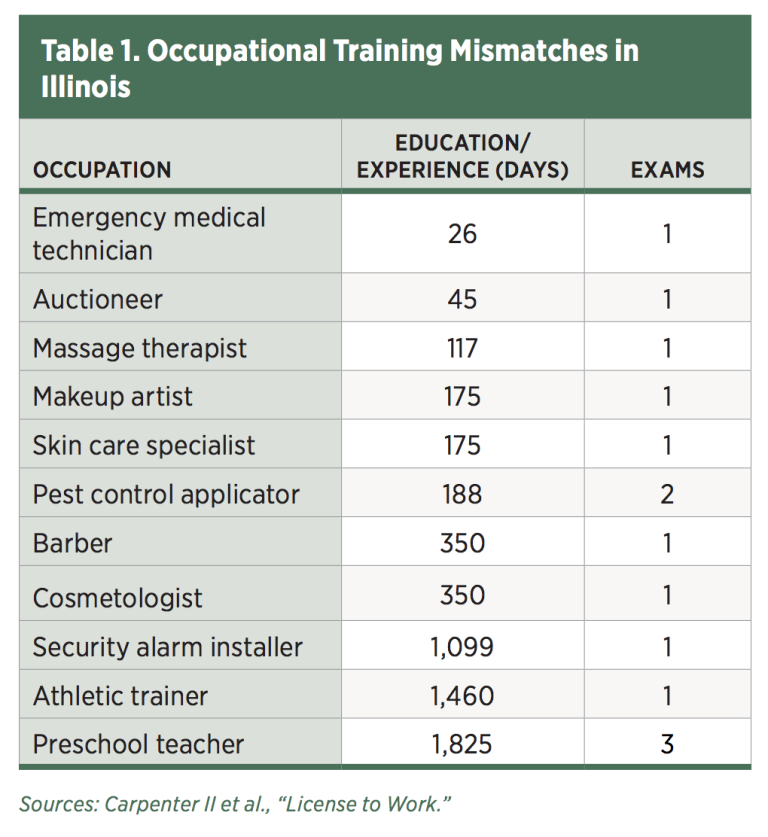
Illinois’s licensing regime also discriminates against immigrants. As researchers in the Department of the Treasury, the Council of Economic Advisers, and the Department of Labor noted in a 2015 report, “in Illinois, if an engineer earns a degree from most universities abroad, she must submit proof that she worked under a U.S. engineer for four years; other work experience abroad will not suffice.”
Illinois state legislators and Governor Bruce Rauner have begun to pursue occupational licensing reform. On August 22, 2016, HB 5973 became law. It prohibits “the Illinois Department of Financial and Professional Regulation . . . from barring former offenders from working in certain fields unless their crimes directly relate to the occupations for which they seek licenses.” More recently, Governor Rauner established the Illinois Competitiveness Council with the goal of saving “Illinoisans at least $250 million in direct license fee costs over the next decade, and sav[ing] Illinois taxpayers and business owners at least 4 million pages in paperwork” by ensuring current regulations are truly necessary, modernized, and easy to understand, while reducing unnecessary requirements. Moreover, the council is specifically instructed to examine the occupational license system to promote “job growth and job creation.”
While these reforms are steps in the right direction, there is still more that can be done to reduce unnecessary regulatory burdens in Illinois. We discuss some additional reforms in the final section of this brief. In the next section, we outline the literature on occupational licensure.
The Economics of Occupational Licensure
Growth in Licensure
Nationally, occupational licenses have expanded dramatically over the last 50 years, and as of 2000, at least 20 percent of US workers were in occupations that required state licenses. When federal and local licenses are included, the percentage of the workforce required to obtain an occupational license reached 29 percent in 2006. This represents a significant increase from the 1950s, when just 5 percent of the workforce was licensed through state laws. This growth in the prevalence of licensure arises primarily from the number of occupations that require a license rather than from a redistribution of the workforce out of jobs that do not require occupational licenses and into jobs that do require licenses.
Licensure and Quality
Licensure is typically justified by legislators and advocates as being necessary to protect the public from subpar products or potential health risks. It is theoretically possible that a well-constructed quality gate will ensure that only high-quality professionals will join an occupation. It is also possible, however, that by limiting the supply of professionals, licensure may undermine competition, thereby depressing quality while driving prices higher. As Kleiner has put it, licensure ensures that “prices and wages will rise as a result of restricting the number of practitioners, which should tend to reduce quality received by consumers.”
This means that the true effect of licensure on quality is an empirical question, the answer to which depends on which of these two forces dominates. A number of studies have assessed the effect of licensure on quality and the weight of evidence suggests that the two effects roughly cancel each other out. As Kleiner put it in his review of the literature,
"From this evidence there is little to show that occupational licensure has a major effect on the quality of services received by consumers or on the demand for the services other than through potential price effects."
Researchers in President Barack Obama’s administration conducted their own review of the literature and reached the same conclusion:
"With the caveats that the literature focuses on specific examples and that quality is difficult to measure, most research does not find that licensing improves quality or public health and safety."
Patrick A. McLaughlin, Jerry Ellig, and Dima Yazji Shamoun recently surveyed 19 studies assessing the effect of occupational licensure on quality. Figure 2 presents the results of their survey. Consistently with the surveys by Kleiner and the Obama administration, they found that the most common finding was neutral, mixed, or unclear. Three studies found that occupational licensure positively affects quality, while four found that it negatively affects quality.
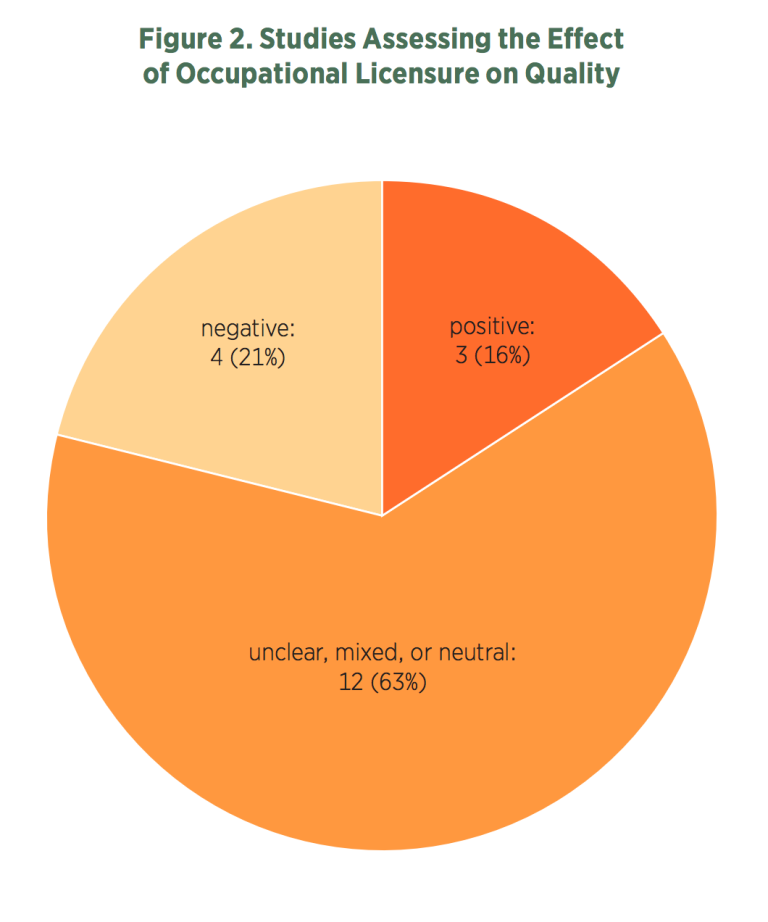
Positive: Arlene Holen, “The Economics of Dental Licensing” (Washington, DC: Public Research Institute, Center for Naval Analysis, 1978); Samuel Claude Martin, “An Examination of the Economic Side Effects of the State Licensing of Pharmacists” (Doctoral Dissertation, University of Tennessee, 1982); Roger Feldman and James W. Begun, “The Effects of Advertising: Lessons from Optometry,” Journal of Human Resources 13 supplement (1978): 247–62. Unclear, mixed, or neutral: Kathryn Healey, “The Effect of Licensure on Clinical Laboratory Effectiveness” (Doctoral Dissertation, University of California, Los Angeles, 1973); John J. Phelan, “Regulation of the Television Repair Industry in Louisiana and California: A Case Study,” Federal Trade Commission, 1974; John F. Cady, Restricted Advertising and Competition: The Case of Retail Drugs (Washington, DC: American Enterprise Institute, 1976); Robert J. Thornton and Andrew R. Weintraub, “Licensing in the Barbering Profession,” Industrial and Labor Relations Review 32, no. 2 (1979): 242–49; Ronald Bond et al., “Effects of Restrictions of Advertising and Commercial Practice in the Professions: The Case of Optometry,” Federal Trade Commission, 1980; Chris Paul, “Physician Licensure Legislation and the Quality of Medical Care,” Atlantic Economic Journal 12, no. 4 (1984): 18–30; David S. Young, The Rule of Experts: Occupational Licensing in America (Washington, DC: Cato Institute, 1987); Morris Kleiner and Daniel L. Petree, “Unionizing and Licensing of Public School Teachers: Impact on Wages and Educational Output,” in When Public Sector Workers Unionize, ed. R. B. Freeman and C. Ichniowski (Chicago: University of Chicago Press, 1988), 305–19; D. D. Goldhaber and D. J. Brewer, “Does Teacher Certification Matter? High School Teacher Certification Status and Student Achievement,” Educational Evaluation and Policy Analysis 22, no. 2 (2000): 129–45; Morris Kleiner and Robert T. Kudrle, “Does Regulation Affect Economic Outcomes? The Case of Dentistry,” Journal of Law and Economics 43, no. 2 (2000): 547–82; David Blau, “Unintended Consequences of Child Care Regulations,” Labour Economics 14, no. 3 (2007): 513–38; Joshua Angrist and Jonathan Guryan, “Does Teacher Testing Raise Teacher Quality? Evidence from State Certification Requirements,” Economics of Education Review 27, no. 5 (2008): 483–503. Negative: Timothy Muris and Fred McChesney, “Advertising, Consumer Welfare, and the Quality of Legal Services: The Case of Legal Clinics” (Working Paper 78-5, Law and Economics Center, University of Miami, Miami, FL, 1978); Sidney Carroll and Robert Gaston, “Occupational Restrictions and the Quality of Service Received: Some Evidence,” Southern Economic Journal 47, no. 4 (1981): 959–76; John E. Kwoka, “Advertising and the Price and Quality of Optometric Services,” American Economic Review 74, no. 1 (1984): 211–16; Mark C. Berger and Eugenia F. Toma, “Variation in State Education Policies and Effects on Student Performance,” Journal of Policy Analysis and Management 13, no. 3 (1994): 477.
If it were true that licenses are necessary to protect the public, one would expect states to more or less uniformly regulate certain professions but not others. In reality, however, there is wide variation across states in terms of occupations regulated and the stringency with which they are regulated. For example, in 4 states, interior designers are heavily regulated—required, on average, to have nearly 2,200 days of education and experience to practice their trade—while in the rest of the country, these professionals are able to offer their services free from regulation with no apparent risk to the public.
Finally, it should be noted that licensure is hardly the only or even the most effective way to ensure quality. Tort law as well as civil and criminal statutes against deceptive trade practices protect consumers from fraud and negligence. Firms post bonds that will be forfeited in the case of negligence, scrupulously guard their reputations and brands, and seek the approval of third-party evaluators such as the Better Business Bureau and Angie’s List. More recently, a new generation of consumer-driven technologies has radically empowered consumers and balanced the information asymmetry that long persisted in some highly technical fields. And if policymakers think private measures are insufficient to protect consumers, there are a number of public regulatory options that are more effective and less likely to be counterproductive. For example, firms might be required to post bonds, or they might simply be required to register their businesses with the state so that consumers can be assured that they are not “fly-by-night” operations.
Licensure and Prices
Economic theory predicts that a restriction in supply will result in higher prices. And, indeed, the empirical research consistently finds this to be the case. According to the Obama administration review,
"The evidence on licensing’s effects on prices is unequivocal: many studies find that more restrictive licensing laws lead to higher prices for consumers. In 9 of the 11 studies we reviewed . . . significantly higher prices accompanied stricter licensing."
Similarly, McLaughlin, Ellig, and Shamoun found that licensure increased prices in all 19 of the studies they surveyed, including studies covering optometry, law, dentistry, and cosmetology.
The effects of these increased prices are not trivial. For example, state nurse practitioner licensing is estimated to raise the price of a well-child checkup by 3 to 16 percent, dental hygienist and dental assistant licensing is estimated to increase the price of a dental visit by 7 to 11 percent, and optometry licensing is estimated to increase the price of eye care by 5 to 13 percent. As is consistent with the literature, none of these studies found that licensing increased quality.
Licensure and Regulatory Privilege
Writing in the Harvard Journal of Law and Public Policy, Paul Larkin Jr. notes a “curious and stubborn fact: Private individuals rarely urge governments to adopt licensing regimes, but private firms often do.” This is one reason why the economic theory of regulation suggests that the primary purpose of licensure is to protect incumbent providers from competition. By limiting supply and raising prices, these rules allow incumbent providers to earn above-normal profits. Indeed, the latest research suggests that licensure raises the wages of licensees by about 14 percent. In other words, occupational licensing is a regulatory privilege to incumbent providers.
This privilege is paid for by consumers in the form of higher prices and by providers unable or unwilling to obtain licenses. The loss to consumers, including some who do not buy because of the higher prices, and the loss to would-be competitors exceeds the gains to the license holders (economists call this a deadweight loss). What’s more, because licensure confers a privilege on license holders, these professionals are willing to expend scarce resources convincing policymakers to contrive and maintain these privileges—a socially wasteful endeavor known as rent-seeking. Being fewer in number and established in their fields, these license holders generally find it easier to organize politically than the large number of consumers and would-be competitors who are harmed by licensure.
The Disparate Impact of Licensure
We have mentioned that those who fail to obtain licenses pay a price in the form of lost income. Research suggests that these burdens often fall on particular communities. For example, military spouses are more likely to be in licensed professions and more likely to relocate from one licensing regime to another, so licensure presents a particularly high barrier for them.
Licensure also presents a higher barrier to immigrants since many states—including Illinois—require domestic work experience. For ex-offenders, occupational licensing is particularly burdensome, as most states make it impossible for those with a past conviction to obtain an occupational license.
As shown in figure 3, McLaughlin, Ellig, and Shamoun’s survey of the literature shows that licensing was found to disparately affect ethnic minorities in 4 of 5 studies.
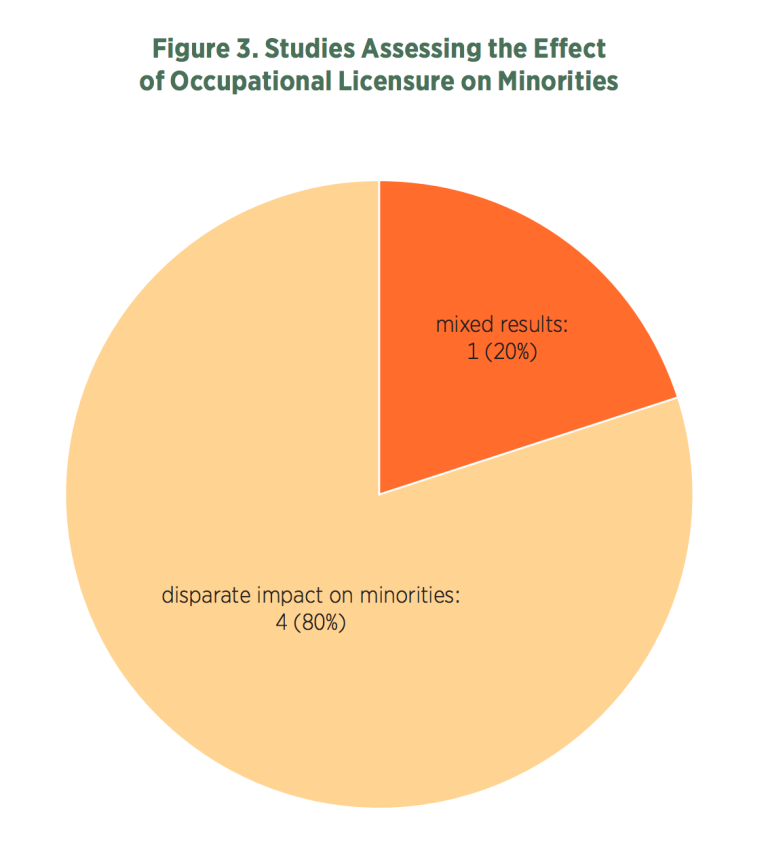
Disparate impact: Stuart Dorsey, “The Occupational Licensing Queue,” Journal of Human Resources 15, no. 3 (1980): 424–34; Maya Federman, David Harrington, and Kathy Krynski, “The Impact of State Licensing Regulations on Low-Skilled Immigrants: The Case of Vietnamese Manicurists,” American Economic Review 96, no. 2 (2006): 237–41; Joshua Angrist and Jonathan Guryan, “Does Teacher Testing Raise Teacher Quality? Evidence from State Certification Requirements,” Economics of Education Review 27, no. 5 (2008): 483–503; David E. Harrington and Jaret Treber, “Designed to Exclude” (report, Institute for Justice, Arlington, VA, February 2009). Mixed results: Marc Law and Mindy Marks, “Effects of Occupational Licensing Laws on Minorities: Evidence from the Progressive Era,” Journal of Law and Economics 52, no. 2 (2009): 351–66.
Reform
While occupational licensure is ostensibly intended to protect consumers from harm, there are many other less burdensome mechanisms to ensure public safety. These include tort liability for harms and civil and criminal penalties against fraud. But they also include several private mechanisms, including private certification, insurance, bond-posting, brand reputation, publicly posted customer feedback such as Yelp and Google reviews, and third-party validation from organizations such as Angie’s List, Consumer Reports, and Underwriters Laboratories.
Competition itself may be the most effective alternative to licensure. As the late economist and regulator Alfred Kahn once put it, “whenever competition is feasible, it is, for all its imperfections, superior to regulation as a means of serving the public interest.”
Policymakers looking to reduce their state’s occupational licensing burden would be wise to follow these steps:
- Pass legislation that sets an ambitious goal for the elimination of licenses and the reduction of licensing burdens.
- Establish an independent commission charged with examining the state’s licensing laws. Its first task should be to identify each license the state requires as well as the burdens associated with each license (fees, exams, required training, education experience, and other limitations). The commission should be charged with evaluating all licenses, should not be dominated by members of the licensed professions, should include consumer representatives, and should include third-party experts such as academics who have no financial stake in licensure. Furthermore, the commission should be guided by a set of criteria for evaluating regulations as listed in table 2.
- The commission should be charged with setting a comprehensive path for licensure elimination and reform. The authorizing legislation should commit elected officials to accepting the commission’s recommendations in their entirety or not at all.
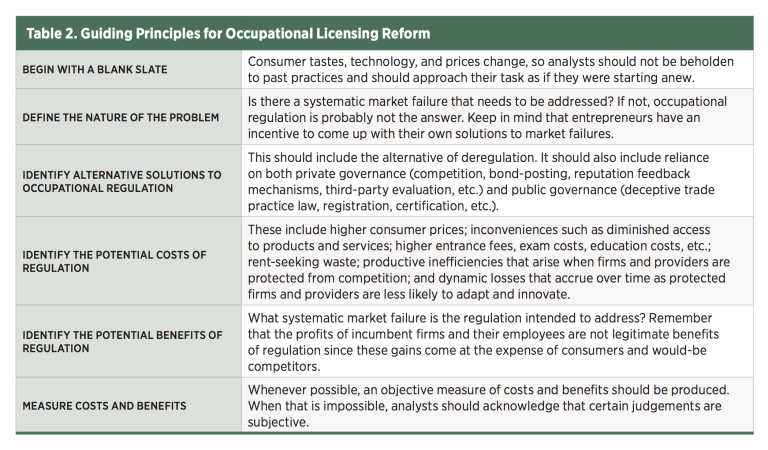
To speak with a scholar or learn more on this topic, visit our contact page.

